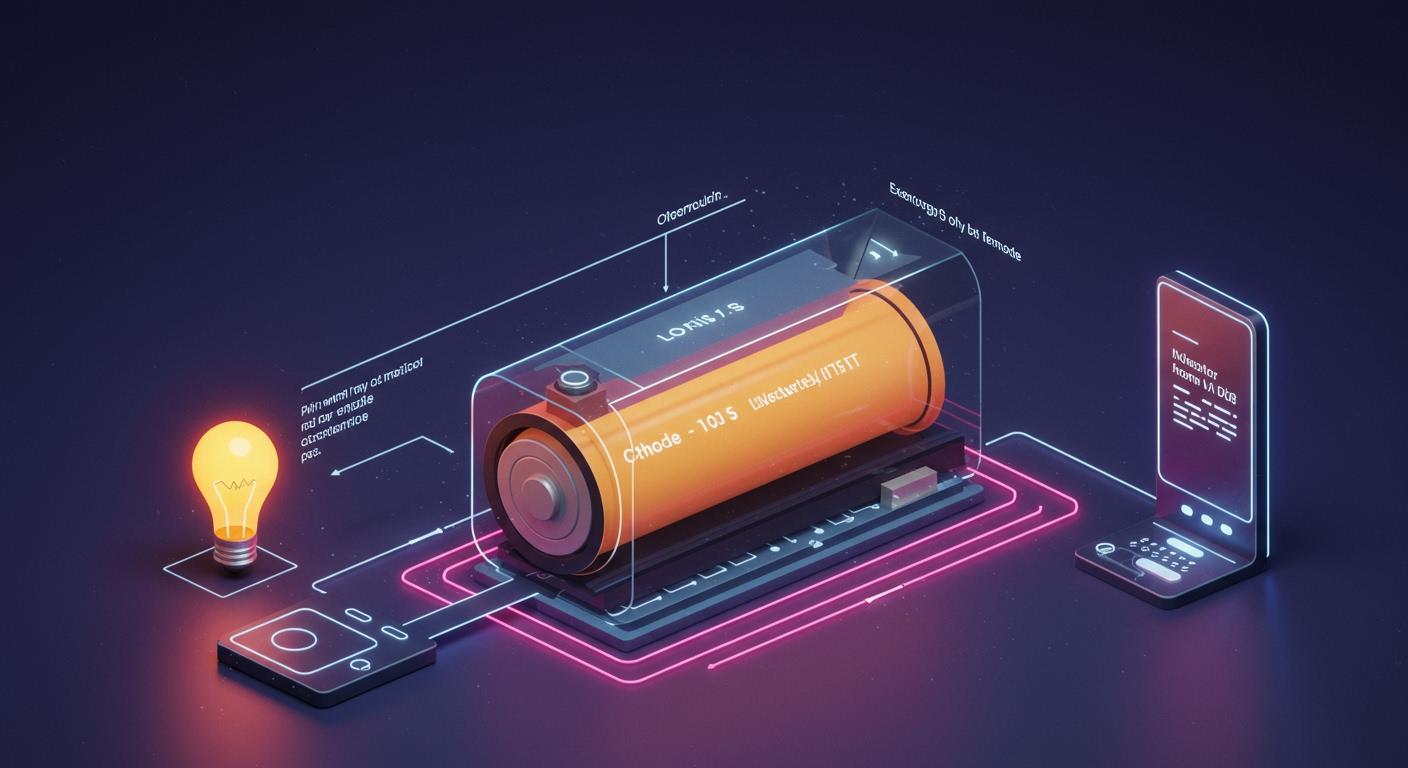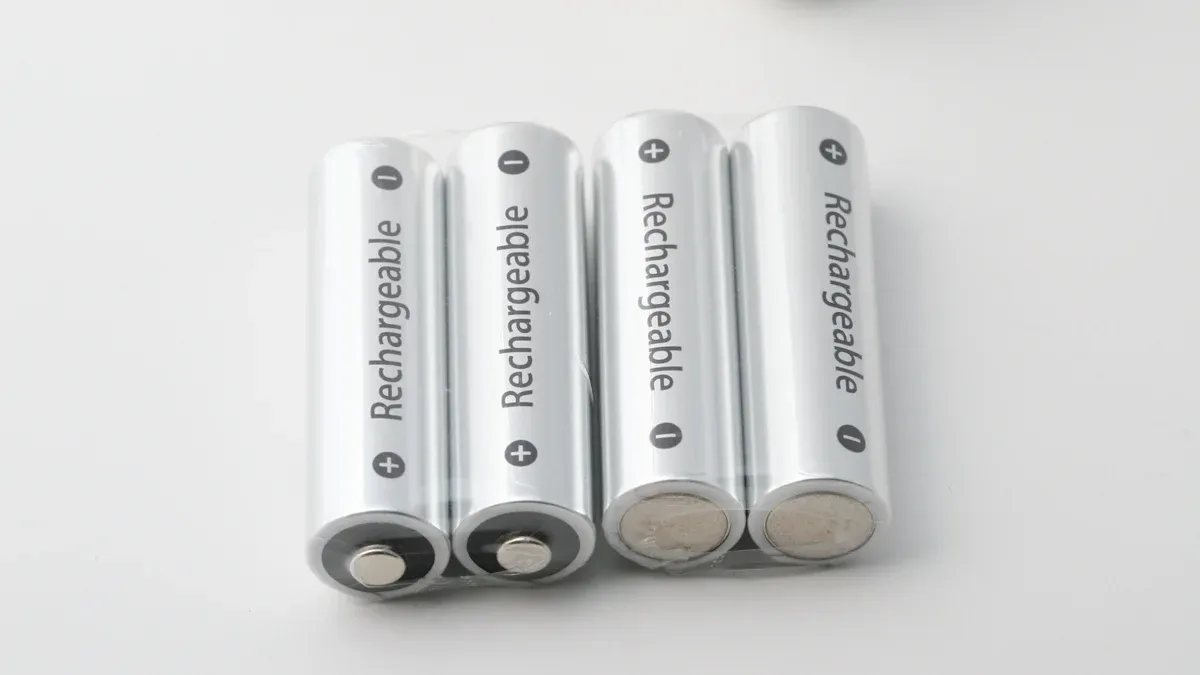How Lithium-ion Batteries Work

You use a lithium-ion battery every day, whether you power up your phone or drive an electric car. Think of a lithium-ion battery as a tiny energy warehouse where lithium ions travel back and forth, like cars on a two-way street, to store and release energy. This movement lets your devices work smoothly and recharge quickly. The demand for lithium-ion batteries has soared, with global electric vehicle sales expected to rise from 2.9 million units in 2020 to 47.3 million by 2032, as shown below:
| Year | Global EV Sales (Units) | Penetration Rate (%) | CAGR (%) |
|---|---|---|---|
| 2020 | 2.9 million | 4.2 | N/A |
| 2032 | 47.3 million | 44.6 | 19 |
You rely on this technology for everything from laptops to electric vehicles.
Key Takeaways
- Lithium-ion batteries are rechargeable and power many devices, from smartphones to electric cars, thanks to their high energy density and long lifespan.
- These batteries consist of three main components: anode, cathode, and electrolyte, which work together to store and release energy safely.
- Charging and discharging involve the movement of lithium ions and electrons, creating a flow of electricity that powers your devices.
- Lithium-ion batteries offer advantages over older types, such as higher energy density, lightweight design, and no memory effect, making them ideal for modern electronics.
- To extend battery life, charge before it drops below 20%, avoid extreme temperatures, and use the original charger for best results.
What Is a Lithium-ion Battery
A lithium-ion battery is a type of rechargeable battery that stores and releases energy by moving lithium ions between two main parts called electrodes. You find these batteries in many devices because they offer high energy density and last longer than older battery types. When you use a device powered by lithium-ion batteries, you benefit from quick charging and reliable performance.
Key Features
Lithium-ion batteries stand out for several reasons. You get more power in a smaller package, which means your phone or laptop stays light and slim. These batteries do not suffer from the "memory effect," so you can recharge them at any time without losing capacity. They also hold their charge longer when not in use.
Tip: Lithium-ion batteries deliver about twice the energy density of nickel-cadmium batteries, making them ideal for portable electronics.
Here is a table that compares key features of lithium-ion batteries and nickel-cadmium batteries:
| Feature | Lithium-Ion | Nickel-Cadmium |
|---|---|---|
| Energy Density | Typically twice as high | Standard level |
| Memory Effect | None | Present |
| Self-Discharge Rate | Less than half | Higher |
| Cell Voltage | 3.6 volts | Lower |
You can see why rechargeable lithium-ion batteries have become the top choice for modern electronics.
Everyday Uses
You use lithium-ion batteries every day, often without thinking about it. These batteries power your cellphone, laptop, and tablet. You also find them in cameras, electric cars, and even electric scooters. If you ride an electric-assist bicycle or drive a plug-in hybrid, you rely on rechargeable lithium batteries for smooth and efficient travel.
Here are some common products that use lithium-ion batteries:
- Smartphones
- Tablets
- Laptop computers
- Cameras
- Electric cars
- Electric scooters
- Electric-assist bicycles
Lithium-ion batteries make your life easier by powering devices you depend on for work, communication, and transportation.
Lithium-ion Batteries: Components

When you look inside lithium-ion batteries, you find three main components that work together to store and release energy. These parts include the anode, the cathode, and the electrolyte. You also see a separator, which plays a key role in battery safety. Each part has a special job, and together they make the battery cell work smoothly.
Anode and Cathode
The anode and cathode act like the two ends of a bridge for lithium ions. The anode stores lithium ions when the battery charges. The cathode receives these ions when the battery discharges. You can think of the anode as a parking lot where lithium ions wait until you need power. The cathode acts as the destination where the ions travel to deliver energy. This movement between the cathode and anode creates the flow of electricity that powers your devices.
| Component | Role in Battery Cell | Simple Analogy |
|---|---|---|
| Anode | Stores lithium ions | Parking lot |
| Cathode | Receives lithium ions | Destination |
Electrolyte and Separator
The electrolyte fills the space between the anode and cathode. It acts like a highway, allowing lithium ions to move back and forth during charging and discharging. Without the electrolyte, the ions would have no path to travel. The separator sits between the anode and cathode, working like a safety gate. It lets lithium ions pass through but blocks electrons, which helps prevent short circuits. This design keeps battery safety high and reduces the risk of overheating or damage.
Note: The separator is essential for battery safety. It stops the anode and cathode from touching, which could cause a dangerous short circuit.
You now see how the three main components—anode, cathode, and electrolyte—along with the separator, make lithium-ion batteries reliable and safe for everyday use.
How Does a Lithium-ion Battery Work

You might wonder, how does a lithium-ion battery work when you plug in your phone or turn on your laptop? The answer lies in the way lithium ions and electrons move inside the battery during the charge and discharge process. This movement creates the energy that powers your devices.
Charging
When you charge your device, you send energy into the lithium-ion battery. Here’s what happens step by step:
- The charger pushes electrons into the anode (the negative side of the battery).
- Lithium ions inside the battery move through the electrolyte from the cathode (the positive side) to the anode.
- The separator acts like a safety gate, letting only lithium ions pass while blocking electrons.
- Electrons travel through an external circuit, not through the separator, and gather at the anode.
- The anode stores both the lithium ions and the electrons, holding the energy until you need it.
Tip: Charging a lithium-ion battery is like filling a water tank. You store energy for later use, and the tank (anode) holds the water (lithium ions) until you open the tap.
This process prepares your battery to deliver power whenever you need it. The battery stores energy by keeping lithium ions and electrons separated at the anode.
Discharging
When you use your device, the lithium-ion battery starts to discharge. Here’s how the process works:
- You turn on your device, and the battery releases stored energy.
- Lithium ions leave the anode and travel back through the electrolyte to the cathode.
- Electrons cannot pass through the separator, so they flow through the external circuit, powering your device along the way.
- The cathode receives both the lithium ions and the electrons, completing the circuit.
Note: The charge and discharge process repeats every time you use and recharge your device. This cycle makes lithium-ion batteries reliable for daily use.
The flow of electrons through your device creates the electricity that runs your phone, laptop, or car. The movement of lithium ions inside the battery keeps the process going smoothly.
| Step | Charging (Storing Energy) | Discharging (Releasing Energy) |
|---|---|---|
| Ion Movement | Cathode → Anode | Anode → Cathode |
| Electron Flow | External circuit to anode | External circuit to device/cathode |
| Energy | Stored in anode | Delivered to your device |
You can see how lithium-ion batteries work by moving ions and electrons in a controlled way. This design gives you efficient energy storage and delivery, while the separator ensures safety by preventing short circuits. Understanding this process helps you appreciate why lithium-ion batteries power so many of your favorite devices.
Lithium-ion Batteries vs. Other Types
Advantages
When you compare rechargeable lithium batteries to older types like nickel-cadmium or lead-acid batteries, you notice several clear benefits. You get more energy packed into a smaller and lighter battery. This means your devices can run longer without adding extra weight. Here are some key points:
- Lithium-ion batteries can reach about twice the energy density of nickel-cadmium batteries.
- You do not have to worry about the memory effect, which can reduce the capacity of nickel-cadmium batteries over time.
You also enjoy easy operation. Rechargeable lithium batteries do not need special maintenance like watering or priming. You can use them right away. They also lose their charge much more slowly when not in use.
| Advantage | Description |
|---|---|
| High Energy Density | You store more energy in the same space. |
| Lightweight | Devices and vehicles stay lighter and easier to handle. |
| Easy Operation and Low Maintenance | No need for extra steps—just charge and use. |
| Low Self-Discharge | Battery loses only 1-2% of its charge per month. |
| Longer Life Span | Some lithium-ion batteries can last up to 3000 cycles at 80% depth of discharge. |
| Extremely Safe | Improved chemical stability and better thermal performance than lead-acid batteries. |
| Load Characteristics | You get steady power output until the battery is almost empty. |
If you look at cycle life, lithium-ion batteries last much longer than lead-acid batteries. For example:
| Battery Type | Cycle Life (Approx.) | Comparison |
|---|---|---|
| Lead-Acid | 300 cycles | Baseline |
| Lithium-Ion (LFPO) | 900 cycles | At least 3 times longer |
Limitations
Even though rechargeable lithium batteries offer many advantages, you should know about their limitations and risks. These batteries can discharge power very quickly if they short-circuit. If the battery terminals touch metal objects like coins or keys, this can cause a dangerous situation.
- Lithium-ion batteries can experience thermal runaway because of their flammable electrolyte. This can lead to fire or explosion if the battery gets too hot.
- The electrolyte inside the battery is volatile and can break down at high voltages, which increases safety risks and can damage the battery.
- You may face restrictions on battery size when traveling by air because higher-powered batteries carry more risk.
Temperature also affects performance and safety. Charging a lithium-ion battery at high temperatures, such as above 30°C, can reduce its capacity quickly. For example, charging at 60°C can drop the battery’s capacity to 60% in just three months.
Tip: Always store and charge your rechargeable lithium batteries at room temperature to keep them safe and working well.
By understanding both the strengths and weaknesses, you can make better choices about how and when to use rechargeable lithium batteries in your devices.
Performance and Variations
Battery Types
You will find several types of lithium-ion batteries, each with unique features. The most common types include standard lithium-ion batteries and lithium iron phosphate batteries (LiFePO₄). These types differ in energy density, safety, cycle life, and cost. The table below helps you compare their main characteristics:
| Feature | Lithium-ion Batteries | Lithium Iron Phosphate Batteries (LiFePO₄) |
|---|---|---|
| Energy Density | 150-250 Wh/kg | 100-150 Wh/kg |
| Security | Improved safety, but risk of thermal runaway | High stability, minimal risk of thermal runaway |
| Cycle Life | 500-1000 cycles | Over 2000 cycles |
| Cost | Generally higher | Generally lower |
You will notice that lithium iron phosphate batteries offer greater stability and longer cycle life, making them a popular choice for applications where safety and durability matter most. In electric vehicles, the 18650 lithium-ion battery stands out as the most widely used type. Manufacturers prefer this battery because it offers mature technology, stable performance, and excellent thermal management. Even though its cell capacity is smaller, you benefit from high consistency and safety in your electric vehicle.
Factors Affecting Performance
Many factors influence how well your lithium-ion battery performs and how long it lasts. Here are the most important ones:
- The materials used in the battery, such as graphite for the anode, lithium-rich metal oxide for the cathode, and PP/PE plastic film for the separator, play a big role in performance and lifespan.
- High capacitance helps extend battery life cycles and improves stability, which is especially important for electric vehicles and 5G devices.
- Features like high cycle life, fast charging, and safety remain top priorities for battery research and development.
Note: Charging speed can affect your battery’s health. Fast charging may cause lithium plating, which reduces capacity and can create internal short circuits. To keep your battery safe and long-lasting, avoid frequent fast charging and follow recommended charging practices.
You can get the best performance from your lithium-ion batteries by choosing the right type for your needs and taking care of them during use and charging.
You now understand how a lithium-ion battery stores and releases energy by moving lithium ions between the anode and cathode. Knowing the roles of each component helps you use your devices safely and efficiently. Here is a quick summary:
| Component/Process | Description |
|---|---|
| Anode | Stores and releases lithium ions |
| Cathode | Receives and releases lithium ions |
| Separator | Ensures safety by blocking electrons |
| Electrolyte | Moves lithium ions between electrodes |
Lithium-ion batteries give you high energy density, long life, and improved safety. Stay curious—future research will bring even better battery solutions!
FAQ
How long does a lithium-ion battery last?
You can expect most lithium-ion batteries to last between 2 and 5 years. The exact lifespan depends on how often you charge and discharge the battery and how well you care for it.
Can you overcharge a lithium-ion battery?
Most modern devices use built-in circuits to stop charging when the battery is full. You do not need to worry about overcharging if you use the charger that came with your device.
Why does my battery lose charge over time?
Every time you charge and use your battery, it goes through a cycle. Over many cycles, the battery’s ability to hold a charge slowly decreases. This is normal for all rechargeable batteries.
Is it safe to use a lithium-ion battery in hot or cold weather?
Extreme temperatures can harm your battery. High heat can cause damage or even make the battery unsafe. Cold weather can reduce performance. Try to keep your device at room temperature for best results.
How can you make your lithium-ion battery last longer?
Tip: Charge your battery before it drops below 20%. Avoid leaving your device in hot places. Use the original charger. These habits help you get the most life from your battery.
-

 May.2025.11.24Ternary Lithium Battery vs Lithium-ion: Complete Comparison Guide (2025 Edition)Learn More
May.2025.11.24Ternary Lithium Battery vs Lithium-ion: Complete Comparison Guide (2025 Edition)Learn More -

 May.2025.11.214S2P 18650 14.8V Battery: Complete Technical Guide, Specs, Applications & SafetyLearn More
May.2025.11.214S2P 18650 14.8V Battery: Complete Technical Guide, Specs, Applications & SafetyLearn More -

 May.2025.11.18PCM vs BMS in Lithium Batteries: What’s the Difference and Which One Do You Need?Learn More
May.2025.11.18PCM vs BMS in Lithium Batteries: What’s the Difference and Which One Do You Need?Learn More -

 May.2025.11.17Custom Li-ion Battery Design for Medical Devices (2025 Comprehensive Guide)Learn More
May.2025.11.17Custom Li-ion Battery Design for Medical Devices (2025 Comprehensive Guide)Learn More -

 May.2025.11.17The Future of Lithium-Ion Batteries: Innovation, Sustainability, and Global Market TrendsLearn More
May.2025.11.17The Future of Lithium-Ion Batteries: Innovation, Sustainability, and Global Market TrendsLearn More















